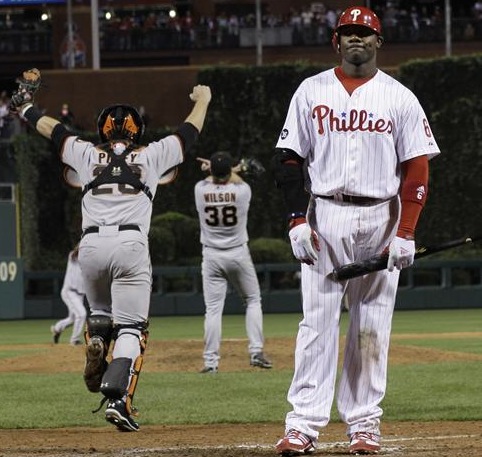
Impetus: Washington Nationals sign pitcher Stephen Strasburg to 7-year deal/extension, worth $175 million dollars
The best thing about baseball contracts like this one is that when the day is over, seldom do the initial headlines come remotely close to the actual payouts by the teams that make these ludicrous deals, paying grown-ass men to play kids’ games.
Case in point, one of the most notorious ironically humorous baseball contracts in history is Bobby Bonilla’s contract signed in 1996. On paper, Bobby Bonilla signed with the Florida Marlins on a deal that dictated he would be paid $23.3 million dollars over four years. Sounds simple enough, right?
The Marlins being the Marlins (read: cheap), would eventually trade Bonilla away in 1998, but the rules of a contract state that the acquiring team assume responsibility of remaining salary, unless negotiated in the deal. The Dodgers paid the remainder of is 1998 salary, before trading him to the Mets after the season, so the Mets would be on the hook for the 1999 and 2000 portions of his deal.
Bonilla was such a clubhouse cancer with the Mets that after 1999, the Mets wanted to be rid of Bonilla, and Bonilla was more than happy to continue his career elsewhere. The problem was that the Mets were still contractually on the hook for the remaining $5.9 million dollars on the deal, but frankly didn’t want to pay it, citing the need to cut payroll and organizational rebuilding.
Ultimately, the Mets and Bonilla came to an agreement, which has to this very day, become one of the greatest jokes in all of baseball history, and a huge contributor to why the Mets remain such a butt of baseball jokes.
Instead of paying Bobby Bonilla $5.9 million dollars in 2000, the Mets would pay him $0. However, it was agreed upon that starting in 2011, the Mets would begin paying Bobby Bonilla approximately $1,193.248.20 every July 1st – for the next 25 years.
It doesn’t take a genius to quickly realize the math doesn’t even come close to equaling the $5.9 million dollars that he was owed in 2000, but closer to five times the amount, $30 million dollars, by the time 2035 rolls around.
The Mets have to live with always having Bobby Bonilla thrown at them in tacky arguments, while Bobby Bonilla, whose career ended in 2001, will cash in every July 1st for pretty much the prime of his retirement years, laughing all the way to the bank, along with the baseball fans who love to make fun of the Mets.
Getting back to Stephen Strasburg, his 7-year extension is very much hovering around the realm of Bobby Bonilla territory. But instead of the Mets being the victims of paying a guy that could very well not be playing for them, much less even playing baseball at all, it’s the Washington Nationals.
On paper, it’s simply announced that Strasburg is getting $175 million dollars over seven years; it’s easy to assume that he’ll be getting paid $25M a year every year, but that’s another aspect of baseball contracts that often go overlooked. In actuality, Strasburg is getting paid at a rate of 15, 15, 35, 25, 15, 15 and 45 between 2017-2023. Weird, the way it dips and peaks, as typically most traditional baseball contracts tend to be back-loaded and escalate from rich-to-Oprah Rich™.
But then again, when it comes to structuring contracts, the Washington Nationals appear to be playing a completely different game than everyone else. Based on the general fallacy of deferred payments demonstrated by the Mets and Bobby Bonilla, salary deferment isn’t a really popular concept around the league. Frankly, lots of teams are staunch believers that only players playing for them should be on the payroll, and not those who are playing for potential competitors or simply not playing at all.
The Nationals however, have been doling out contracts to their superstars acquisitions with deferred payments for a little while now, with Stephen Strasburg being the most recent of guys to potentially be making money long after his Nationals and/or baseball career may have ended. So despite the fact that you’d think he will have been paid $175 by the time 2023’s season ends, he’ll actually have been paid “just” $105 million.
The Nationals and Stephen Strasburg agreed to defer a total of $70 million dollars by taking chunks out of his annual salaries during the life of the contract, which will begin being paid out to Strasburg in $10M annual payments between 2024 and 2030.
Basically, it’s like Bobby Bonilla’s agreement, but worse for the Nationals in the fact that he’s getting $10M a year instead of $1.2M, but a little better in the sense that it’s “only” on the books for ten years instead of 25.
By the time the 2023 season ends, Stephen Strasburg will be 34 years old. That’s still an age in which a pitcher might be able to cash in on one last contract, or given the fact that Strasburg has already been on the DL numerous times, and has a tendency to perform extremely temperamentally based on various weather conditions, I’d wager that either he’ll be a mediocre middle-of-the pack innings eating starter, or in the bullpen.
Either way, it’s kind of shameful for the Nationals no matter what happens after 2023. Either he’s on the Nationals’ payroll as an overpaid member of the team, playing for another team, or not playing at all, but still getting paid like he is; for ten years.
And what makes this whole thing funnier? That’s just Stephen Strasburg’s deal. I haven’t even accounted for his teammate Max Scherzer’s contract, which I never bothered paying attention to until this train of thought left the station.
Like Strasburg, Scherzer is on a massive contract, with massive deferred money. On paper, Scherzer signed for 7 years, and $210 million dollars, but only half of that is being paid during the life of the contract. The other half, $105 million dollars, will be paid out in annual chunks of $15M a year, between the years of 2022 and 2028.
After 2021, Scherzer will be 37 years old. He’ll be at an even bigger risk to having aged out of his talent, or even be capable of playing baseball any further, but still be capable of playing, possibly. But then the Nationals will be paying him $15M a year, to potentially be playing for someone else, or not at all.
Strasburg and Scherzer’s deferred payment plans overlap between the years of 2024-2028. That’s five full seasons in which the Washington Nationals will be allocating $25M a year, to two players that will either be not even close to worth that much money, playing for someone else, or not playing at all.
To put it in perspective, the Nationals basically already signed a free agent in 2024, to a 5-year, $125 million dollar deal. Except it’s already guaranteed to be an ineffective player, practically imaginary, that doesn’t come remotely close to earning back what he’s making.
In other words, the Washington Nationals have signed Ryan Howard in 2024.
The Nationals have kind of put themselves into a position where they kind of need to win a World Series before like 2022. Given the fact that they’ve piled the financial obligations of the present into a date in the future, the only thing that can save the organization from a colossal failure, is success.
Sure, the Lerner family, who owns the Nationals are extremely savvy and smart financial minds, and there’s always the chance that when the future does arrive, they’ll restructure or work something out which frees up the payroll some more, but as we stand in this date in time, it certainly appears that the Nationals are selling a tremendous amount of tomorrow in order to ensure the success of today; which is made even more ironic that the Nationals aren’t running away with the division but currently sputtering and duking it out with the Mets.
The popular belief is that one championship can buy anywhere from 1-3 years of fan forgiveness, so it’s up for debate that even one World Series crown will be perceived as worth it, given how much money the Nationals are spending.
*Even more LOL: 2024 is the final year in which the Nationals will be paying $2M deferred payments to Rafael Soriano, who will be making $2M a year between 2018-2024. He last pitched in the big leagues in 2015. So, in 2024, add Soriano’s $2M on top of the $25M owed to Strasburg and Scherzer, and the Nationals effectively have $27M allocated to three guys who might not even be on the team.
